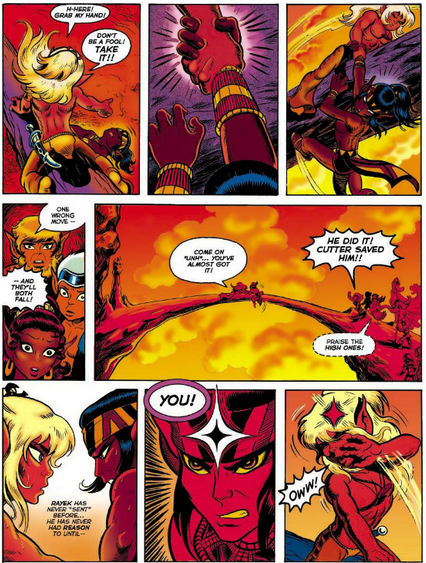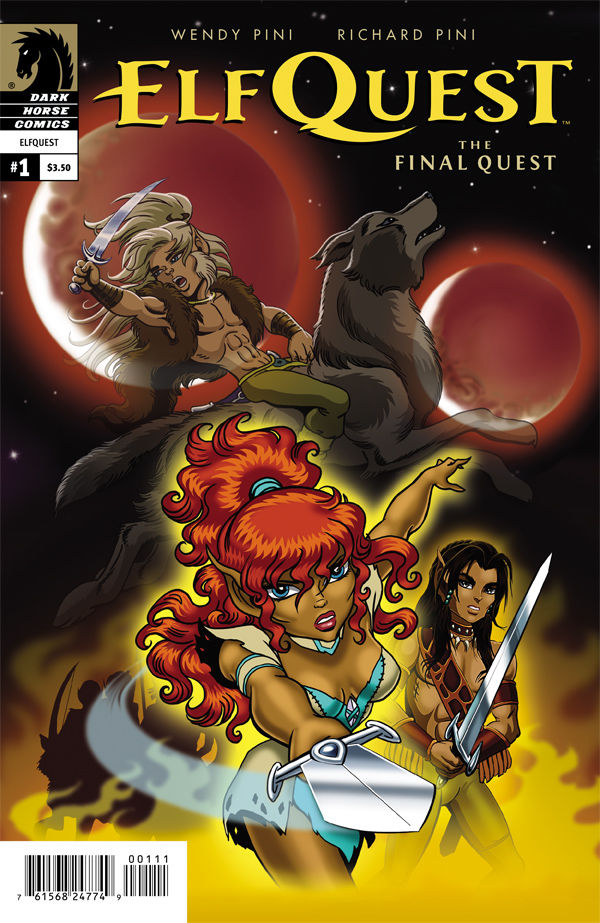After thirty years of elves, wolves, wars, magic, and even time-travel, Wendy and Richard Pini’s epic fantasy Elfquest begins its “Final Quest” at its new publisher, Dark Horse Comics. First published in 1978, Elfquest is the brainchild of the Pinis, with nearly every title in the series written by the pair and illustrated by Wendy. The Pinis boldly discarded the traditional image of elves as tall, ethereal beings in the first issue’s bloody introduction, instead focusing on the short, feral-looking hunters known as the Wolfriders. For readers sick of worn-out Tolkien imitators, Elfquest was a breath of fresh air, and Wendy Pini was one of the first American comic book artists to be influenced by Japanese manga like Lone Wolf and Cub and Kamui. (Sometimes dismissed at first glance as “kiddy stuff” due to the big-eyed elves, Elfquest deals with mature themes no less than war, prejudice, and, um, orgies.)
The “Original Quest” begins with Cutter, the young, hotheaded chief of the Wolfriders, leading his tribe to sanctuary after a fiery battle with their human enemies destroys their home. Cutter encounters the peaceful, desert-dwelling Sun Folk–including his true love Leetah and lifelong rival Rayek–and the Wolfriders learn that they are not the last of their kind. Cutter becomes a visionary leader, determined to discover and unite the elves scattered across the World of Two Moons. His journey leads him to the Gliders, flying elves dominated by the menacing Winnowill, and the fierce arctic tribe of Go-Backs. The Wolfriders and Go-Backs join forces against an enemy army of trolls; the war is costly, but the prize is no less than the elves’ ancestral home, the Palace of the High Ones. There, Cutter uncovers a figure from the past, and the elves’ unearthly origins are revealed
The original quest ran for 21 self-published issues (later reprinted by Marvel and DC Comics), eventually followed by two miniseries. The 90s saw a boom in Elfquest content, as several spin-offs by new writers and artists expanded the universe beyond Cutter and his kin. The results of these issues were mixed, and the Pinis tied up the titles with a final battle against Winnowill. An ongoing anthology simply titled Elfquest brought a creative resurgence (“Dreamtime” is one of the series’ best) but that title ended as well.
The Elfquest publishing schedule became sporadic in the 21st century–a publishing deal with DC Comics led to new works “The Searcher and The Sword” and “The Discovery” (where the Wolfriders meet the Wavedancers–yep, mer-elves), but also disastrously awful reprints of the first series that reformatted Wendy Pini’s original artwork. The Pinis had promised fans a story called “The Final Quest” for over a decade, before the first pages of the prologue began serialization online at Boing Boing, of all places. (Cutter’s damn quest takes him everywhere.) Despite these ups and downs, Elfquest has maintained a thriving cult following for over three decades.
Now, after all these years, “The Final Quest” is here.
Time has passed. Cutter is now a grandfather, the elves are united, and the Wolfriders dwell beside the magical Palace of the High Ones, but peace isn’t perfect. Life in the palace grants security and serenity, but also stagnation and complacency, and it’s the antithesis of the “Way” of the Wolfriders that’s guided them to this point. The Wolfriders have typically led short, brutal lives, but they represent freedom and choice.
Elfquest has never been a standard “good vs. evil” fantasy, and the central conflict here may be the choice between mortality and immortality. Caught in the crossroads is Moonshade, who considers a choice that may separate her from her lifemate Strongbow forever. Moonshade and Strongbow have always been the “old married couple” of the series: steadfast, joined-at-the-hip, and dedicated to the Way. It’s to the Pinis’ credit that they’re not afraid to challenge the status quo and make us question what we know about their characters. Will Cutter’s tribe die as Wolfriders, or will they become something else?
Less philosophical is the secondary plot about Cutter’s daughter Ember and her splinter tribe of Wolfriders, as they prepare to settle their scores with the human warlord Angrif Djunn. Of course, the conflict between elves and humans was in the very first pages of Elfquest #1 thirty years ago, so the more things change, the more they stay the same. I’ve never been a fan of Ember’s lover Teir or the mysteries surrounding him, and it doesn’t help that he’s the star of the most melodramatic scenes in the issue. (“Don’t leave me!” Teir cries as he remembers his mother’s abandonment.) Luckily the rough-and-tumble warriors Krim and Pike are there to liven up every scene they’re in.
The Final Quest #1 is a solid, enjoyable issue, and the storyline seems to have righted itself after the uneven prologue and its unintentionally hilarious “shocker” ending. Wendy Pini’s artwork is in top form, with strong, clean lines that look great under Sonny Strait’s warm colors. (Fans still cringing over the neon Lisa Frank nightmare color scheme seen in “The Discovery” need not worry.)
As its title implies, Elfquest: The Final Quest isn’t new reader friendly. By now Elfquest features dozens of characters and has spanned hundreds of years, and the story dives right in assuming familiarity with its colorful world. Much of “The Final Quest” is about weaving dangling plot threads (some pretty frayed) back into a single tapestry, and longtime readers will rejoice–or scream–as the Pinis reveal the fates of some fan favorite characters. (If you are a new reader interested in jumping into Elfquest, the entire back library is available to read for free on the official Elfquest website.)
I’m a longtime fan of Elfquest–it was my first “serious” comic after a childhood gorging on Betty and Veronica digests–so every time the series returns from hiatus it feels like an event. It’s been a long, bumpy road waiting for “The Final Quest”, and it may be impossible to live up to fan anticipation, but on the World of Two Moons, anything can happen.
Kayleigh Hearn is one of potentially millions of women on the internet and her writing can be found at Womenwriteaboutcomics.com.





It’s really awesome to see Elfquest on the shelves again, and this time to also have the digital option too (which is now my preferred way of reading it) from Dark Horse. Great review, but I have a different take on your more critical comments:
1. What was “disastrously awful” about the DC publications? The manga versions are actually my go-to version when I want to read the back story. I love seeing the art in black and white and I though Wendy did a stellar job translating the art into the smaller page format. The archives were well done too. The colors were a little too saturated in parts of the first book, but honestly, I like my Elfquest richly colored.
2. I totally LOL’d at your “neon Lisa Frank nightmare color scheme” comment about The Discovery, but considering that particular story took place in the glowing crystal Palace and a beautiful tropical, ocean oasis, I do think a rich, bright color palette kind of fit the bill for that story.
3. I won’t lie and say that I can’t see how one would find wicked humor in the ending of the FInal Quest Special, but one of the best things about Elfquest is its innocent earnestness (something that is sorely lacking in today’s “gritty” and gratuitous comics fare, and the snarky “wit” of the anonymous internet commenter) and the reaction of the characters to that event was so refreshingly real and sweet that it really is a great example of what makes Elfquest stand out.